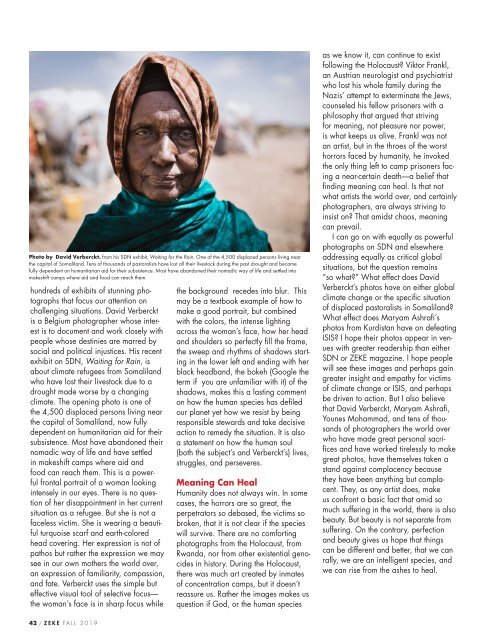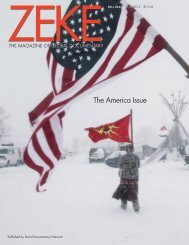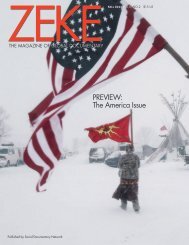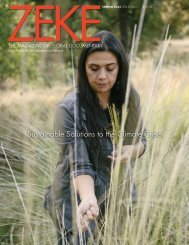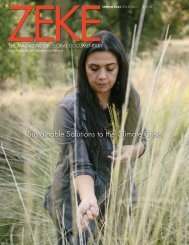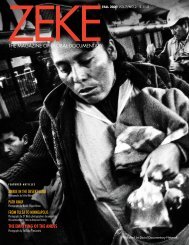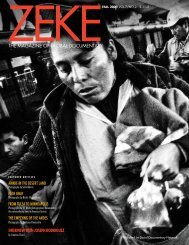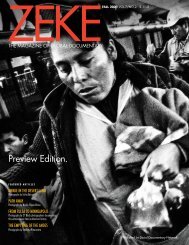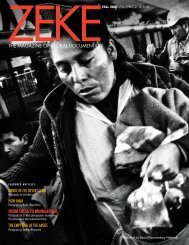ZEKE Fall 2019
Contents includes: "Youth of Belfast" by Toby Binder, and "Delta Hill Riders" by Rory Doyle, winners of ZEKE Award for Documentary Photography "Rising Tides" with photographs by Sean Gallagher, Lauren Owens Lambert, and Michael O. Snyder "Out of the Shadows: Shamed Teen Mothers of Rwanda" by Carol Allen Storey Interview with Lekgetho Makola, Head of Market Photo Workshop, South Africa, by Caterina Clerici "Why Good Pictures of Bad Things Matter" by Glenn Ruga Book Reviews and more...
Contents includes:
"Youth of Belfast" by Toby Binder, and "Delta Hill Riders" by Rory Doyle, winners of ZEKE Award for Documentary Photography
"Rising Tides" with photographs by Sean Gallagher, Lauren Owens Lambert, and Michael O. Snyder
"Out of the Shadows: Shamed Teen Mothers of Rwanda" by Carol Allen Storey
Interview with Lekgetho Makola, Head of Market Photo Workshop, South Africa, by Caterina Clerici
"Why Good Pictures of Bad Things Matter" by Glenn Ruga
Book Reviews and more...
- No tags were found...
You also want an ePaper? Increase the reach of your titles
YUMPU automatically turns print PDFs into web optimized ePapers that Google loves.
Photo by David Verberckt. from his SDN exhibit, Waiting for the Rain. One of the 4,500 displaced persons living near<br />
the capital of Somaliland. Tens of thousands of pastoralists have lost all their livestock during the past drought and became<br />
fully dependent on humanitarian aid for their subsistence. Most have abandoned their nomadic way of life and settled into<br />
makeshift camps where aid and food can reach them.<br />
hundreds of exhibits of stunning photographs<br />
that focus our attention on<br />
challenging situations. David Verberckt<br />
is a Belgium photographer whose interest<br />
is to document and work closely with<br />
people whose destinies are marred by<br />
social and political injustices. His recent<br />
exhibit on SDN, Waiting for Rain, is<br />
about climate refugees from Somaliland<br />
who have lost their livestock due to a<br />
drought made worse by a changing<br />
climate. The opening photo is one of<br />
the 4,500 displaced persons living near<br />
the capital of Somaliland, now fully<br />
dependent on humanitarian aid for their<br />
subsistence. Most have abandoned their<br />
nomadic way of life and have settled<br />
in makeshift camps where aid and<br />
food can reach them. This is a powerful<br />
frontal portrait of a woman looking<br />
intensely in our eyes. There is no question<br />
of her disappointment in her current<br />
situation as a refugee. But she is not a<br />
faceless victim. She is wearing a beautiful<br />
turquoise scarf and earth-colored<br />
head covering. Her expression is not of<br />
pathos but rather the expression we may<br />
see in our own mothers the world over,<br />
an expression of familiarity, compassion,<br />
and fate. Verberckt uses the simple but<br />
effective visual tool of selective focus—<br />
the woman’s face is in sharp focus while<br />
the background recedes into blur. This<br />
may be a textbook example of how to<br />
make a good portrait, but combined<br />
with the colors, the intense lighting<br />
across the woman’s face, how her head<br />
and shoulders so perfectly fill the frame,<br />
the sweep and rhythms of shadows starting<br />
in the lower left and ending with her<br />
black headband, the bokeh (Google the<br />
term if you are unfamiliar with it) of the<br />
shadows, makes this a lasting comment<br />
on how the human species has defiled<br />
our planet yet how we resist by being<br />
responsible stewards and take decisive<br />
action to remedy the situation. It is also<br />
a statement on how the human soul<br />
(both the subject’s and Verberckt’s) lives,<br />
struggles, and perseveres.<br />
Meaning Can Heal<br />
Humanity does not always win. In some<br />
cases, the horrors are so great, the<br />
perpetrators so debased, the victims so<br />
broken, that it is not clear if the species<br />
will survive. There are no comforting<br />
photographs from the Holocaust, from<br />
Rwanda, nor from other existential genocides<br />
in history. During the Holocaust,<br />
there was much art created by inmates<br />
of concentration camps, but it doesn’t<br />
reassure us. Rather the images makes us<br />
question if God, or the human species<br />
as we know it, can continue to exist<br />
following the Holocaust? Viktor Frankl,<br />
an Austrian neurologist and psychiatrist<br />
who lost his whole family during the<br />
Nazis’ attempt to exterminate the Jews,<br />
counseled his fellow prisoners with a<br />
philosophy that argued that striving<br />
for meaning, not pleasure nor power,<br />
is what keeps us alive. Frankl was not<br />
an artist, but in the throes of the worst<br />
horrors faced by humanity, he invoked<br />
the only thing left to camp prisoners facing<br />
a near-certain death—a belief that<br />
finding meaning can heal. Is that not<br />
what artists the world over, and certainly<br />
photographers, are always striving to<br />
insist on? That amidst chaos, meaning<br />
can prevail.<br />
I can go on with equally as powerful<br />
photographs on SDN and elsewhere<br />
addressing equally as critical global<br />
situations, but the question remains<br />
“so what?” What effect does David<br />
Verberckt’s photos have on either global<br />
climate change or the specific situation<br />
of displaced pastoralists in Somaliland?<br />
What effect does Maryam Ashrafi’s<br />
photos from Kurdistan have on defeating<br />
ISIS? I hope their photos appear in venues<br />
with greater readership than either<br />
SDN or <strong>ZEKE</strong> magazine. I hope people<br />
will see these images and perhaps gain<br />
greater insight and empathy for victims<br />
of climate change or ISIS, and perhaps<br />
be driven to action. But I also believe<br />
that David Verberckt, Maryam Ashrafi,<br />
Younes Mohammad, and tens of thousands<br />
of photographers the world over<br />
who have made great personal sacrifices<br />
and have worked tirelessly to make<br />
great photos, have themselves taken a<br />
stand against complacency because<br />
they have been anything but complacent.<br />
They, as any artist does, make<br />
us confront a basic fact that amid so<br />
much suffering in the world, there is also<br />
beauty. But beauty is not separate from<br />
suffering. On the contrary, perfection<br />
and beauty gives us hope that things<br />
can be different and better, that we can<br />
rally, we are an intelligent species, and<br />
we can rise from the ashes to heal.<br />
42 / <strong>ZEKE</strong> FALL <strong>2019</strong>


